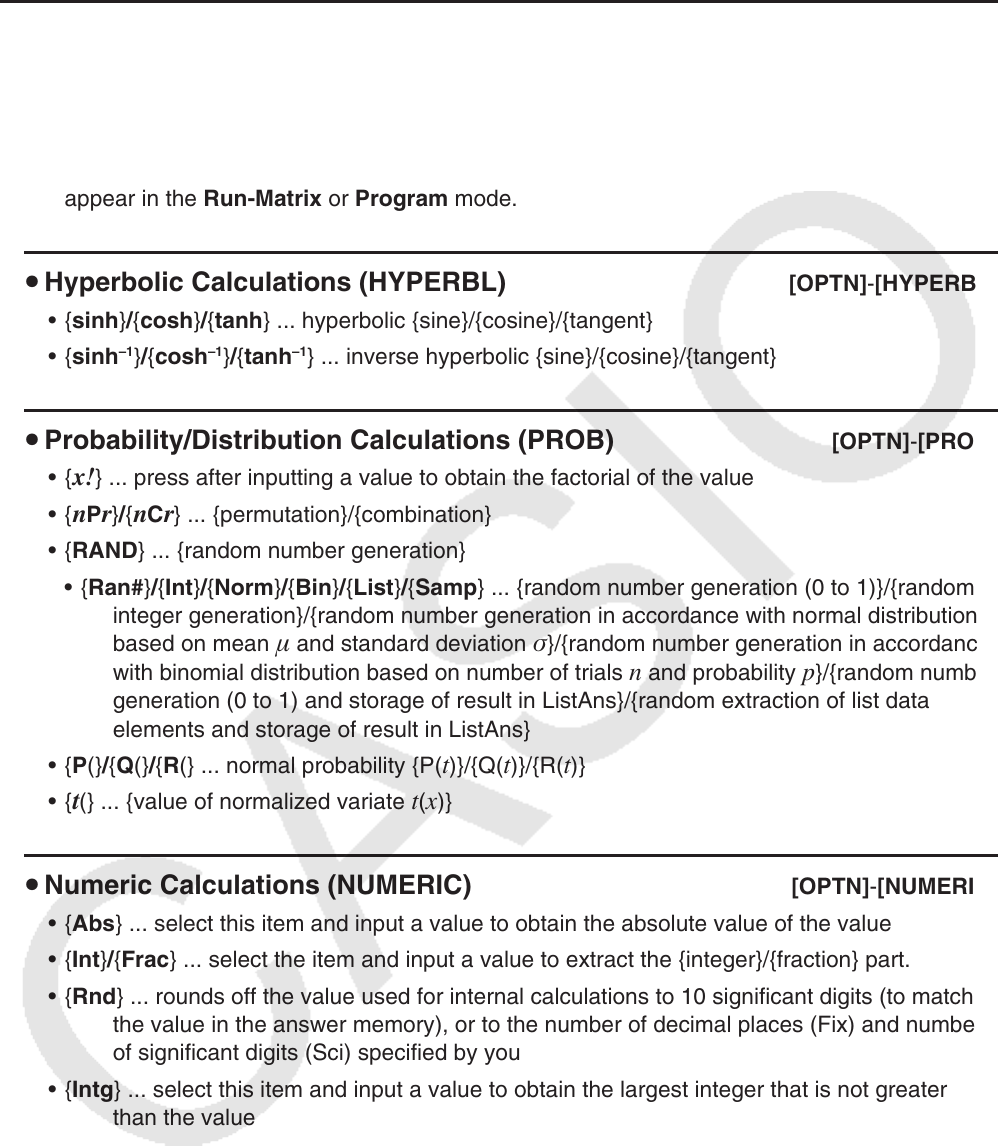User Manual
Table Of Contents
- Contents
- Getting Acquainted — Read This First!
- Chapter 1 Basic Operation
- Chapter 2 Manual Calculations
- 1. Basic Calculations
- 2. Special Functions
- 3. Specifying the Angle Unit and Display Format
- 4. Function Calculations
- 5. Numerical Calculations
- 6. Complex Number Calculations
- 7. Binary, Octal, Decimal, and Hexadecimal Calculations with Integers
- 8. Matrix Calculations
- 9. Vector Calculations
- 10. Metric Conversion Calculations
- Chapter 3 List Function
- Chapter 4 Equation Calculations
- Chapter 5 Graphing
- 1. Sample Graphs
- 2. Controlling What Appears on a Graph Screen
- 3. Drawing a Graph
- 4. Saving and Recalling Graph Screen Contents
- 5. Drawing Two Graphs on the Same Screen
- 6. Manual Graphing
- 7. Using Tables
- 8. Modifying a Graph
- 9. Dynamic Graphing
- 10. Graphing a Recursion Formula
- 11. Graphing a Conic Section
- 12. Drawing Dots, Lines, and Text on the Graph Screen (Sketch)
- 13. Function Analysis
- Chapter 6 Statistical Graphs and Calculations
- 1. Before Performing Statistical Calculations
- 2. Calculating and Graphing Single-Variable Statistical Data
- 3. Calculating and Graphing Paired-Variable Statistical Data (Curve Fitting)
- 4. Performing Statistical Calculations
- 5. Tests
- 6. Confidence Interval
- 7. Distribution
- 8. Input and Output Terms of Tests, Confidence Interval, and Distribution
- 9. Statistic Formula
- Chapter 7 Financial Calculation
- Chapter 8 Programming
- Chapter 9 Spreadsheet
- Chapter 10 eActivity
- Chapter 11 Memory Manager
- Chapter 12 System Manager
- Chapter 13 Data Communication
- Chapter 14 Geometry
- Chapter 15 Picture Plot
- Chapter 16 3D Graph Function
- Appendix
- Examination Mode
- E-CON4 Application (English)
- 1. E-CON4 Mode Overview
- 2. Sampling Screen
- 3. Auto Sensor Detection (CLAB Only)
- 4. Selecting a Sensor
- 5. Configuring the Sampling Setup
- 6. Performing Auto Sensor Calibration and Zero Adjustment
- 7. Using a Custom Probe
- 8. Using Setup Memory
- 9. Starting a Sampling Operation
- 10. Using Sample Data Memory
- 11. Using the Graph Analysis Tools to Graph Data
- 12. Graph Analysis Tool Graph Screen Operations
- 13. Calling E-CON4 Functions from an eActivity

2-14
4. Function Calculations
k Function Menus
This calculator includes five function menus that give you access to scientific functions not
printed on the key panel.
• The contents of the function menu differ according to the mode you entered from the Main
Menu before you pressed the K key. The following examples show function menus that
appear in the Run-Matrix or Program mode.
u Hyperbolic Calculations (HYPERBL) [OPTN]-[HYPERBL]
• {sinh}/{cosh}/{tanh} ... hyperbolic {sine}/{cosine}/{tangent}
• {sinh
–1
}/{cosh
–1
}/{tanh
–1
} ... inverse hyperbolic {sine}/{cosine}/{tangent}
u Probability/Distribution Calculations (PROB) [OPTN]-[PROB]
• {
x!} ... press after inputting a value to obtain the factorial of the value
• {
nPr}/{nCr} ... {permutation}/{combination}
• {RAND} ... {random number generation}
• {Ran#}/{Int}/{Norm}/{Bin}/{List}/{Samp} ... {random number generation (0 to 1)}/{random
integer generation}/{random number generation in accordance with normal distribution
based on mean
and standard deviation }/{random number generation in accordance
with binomial distribution based on number of trials n and probability p}/{random number
generation (0 to 1) and storage of result in ListAns}/{random extraction of list data
elements and storage of result in ListAns}
• {P(}/{Q(}/{R(} ... normal probability {P(
t)}/{Q(t)}/{R(t)}
• {
t(} ... {value of normalized variate t(x)}
u Numeric Calculations (NUMERIC) [OPTN]-[NUMERIC]
• {Abs} ... select this item and input a value to obtain the absolute value of the value
• {Int}/{Frac} ... select the item and input a value to extract the {integer}/{fraction} part.
• {Rnd} ... rounds off the value used for internal calculations to 10 significant digits (to match
the value in the answer memory), or to the number of decimal places (Fix) and number
of significant digits (Sci) specified by you
• {Intg} ... select this item and input a value to obtain the largest integer that is not greater
than the value
• {RndFix} ... rounds off the value used for internal calculations to specified digits (0 to 9) (see
page 2-2)
• {GCD} ... {greatest common divisor for two values}
• {LCM} ... {least common multiple for two values}
• {MOD} ... {remainder of division (remainder output when
n is divided by m)}
• {MOD_Exp} ... {remainder when division is performed on a power value (remainder output
when
n is raised to p power and then divided by m)}










